
台湾本島はサツマイモの形をしており、全長394km、幅144km です。この小さな島には、標高3,000メートル以上の山が274座 も存在します。これらの山々は、島の中央部と東部に集中しており、主に阿里山山脈、中央山脈、雪山山脈、玉山山脈に属しています。台湾の地形のうち、平地はわずか26%しかなく、そのほとんどが西海岸に広がっています。
山岳地帯には、先住民族の集落や農場を結ぶ整備された道路 が通っています。台風や豪雨、地震によって頻繁に土砂崩れが発生し、一部の道路が破壊・封鎖される ことがありますが、修復作業は迅速に行われます。修復に時間がかかる場合は、交通規制が実施される こともあります。
私が初めてEddie Chen(著名なサイクリングライター、Vlogger、「台灣 ‧ 用騎的最美 (台湾 ‧ 自転車で巡る最高の美しさ)」の創設者) が2019年に始めたプロジェクト「北進武嶺・南出鵝鑾鼻、台湾縦断500マイル」について知ったとき、衝撃を受けました。富貴角(台湾最北端)から鵝鑾鼻(最南端)まで、山岳地帯を縦断するルート。これは大胆かつ野心的な挑戦です。しかし、サイクリング愛好者にとっては非常に魅力的なルートでもあります。標高差を避けるのではなく、サツマイモを切り裂くように山岳地帯を力強く駆け抜ける のです。このルートの総距離は760km、獲得標高は26,087m、最高地点は標高3,275mの武嶺です。
そして、2023年4月、私はついにEddieがガイドする5日間のサイクリングツアーに参加し、このルートの前半を走ることができました。ここでは、その経験を共有します。これが、ルートを計画するサイクリストの参考 になれば幸いです。
第1日目:富貴角灯台から角板山へ(距離 109km、獲得標高 1,789m)
午前6時に松山駅で集合し、サポートカーに乗り込み、出発地点である富貴角灯台へ向かいました。サポートカーなしで自力で行く場合は、前日に白沙湾または三芝区の小さなホテルに宿泊するのが良い選択肢です。
灯台はいつも通り魅力的でしたが、天候はあまり良くありませんでした。登坂を開始したときにはすでに雨が降り始め、陽明山の頂上に近づくにつれ、霧がどんどん濃くなっていきました。私はこれまでに何度も陽明山を訪れたことがありますが、このような天候の中で走るのは初めてでした。泥が車輪のリムに付着し、ブレーキをかけるたびに不快な摩擦音がしました。特に急な下り坂では、その音がさらに際立ちました。
私のホイールセットは頑丈なアルミ製ですが、長く急な下り坂を5日間も走るとなると、ブレーキパッドが持つか心配でした。昼休憩の際、チームメンバーの1人がブレーキパッドが限界まで摩耗しているのを発見しました。台北市内を通過する際に、念のため予備のブレーキパッドを購入しました。
午後4時、大稻埕碼頭広場でその日のライドを終え、サポートカーに乗って角板山へ移動しました。夕食は午後6時に予約しており、そのレストランは私たちのためだけに営業を開けてくれていました。夕方になると交通量が増えるため、彼らを待たせないように時間厳守で向かいました。
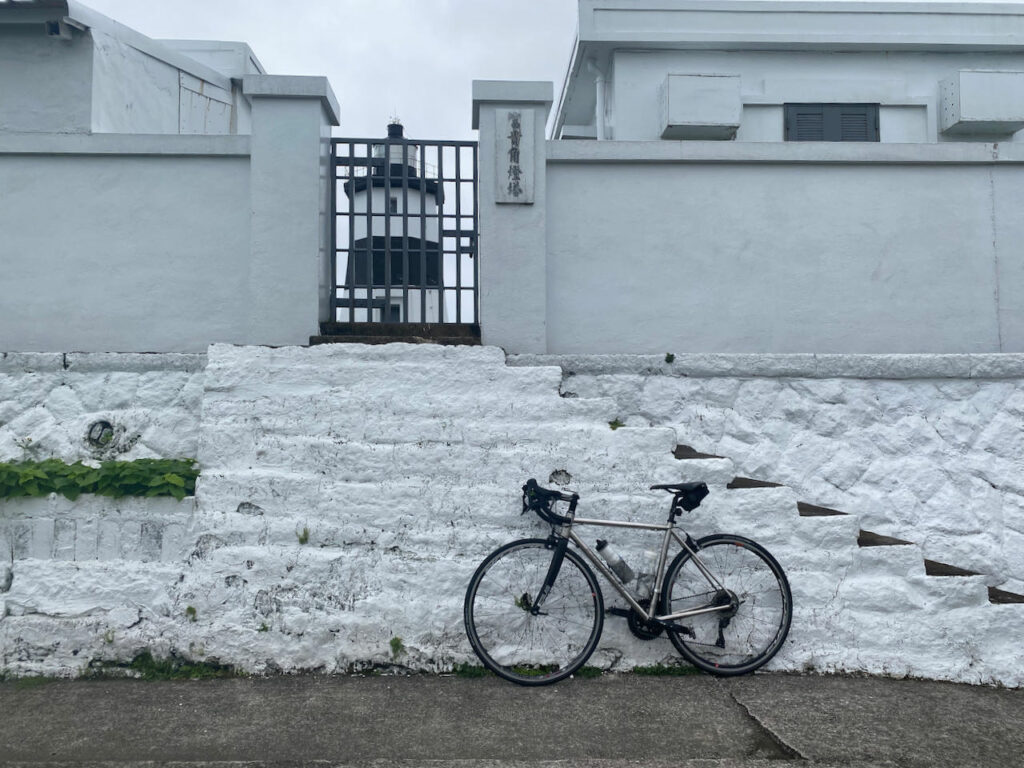
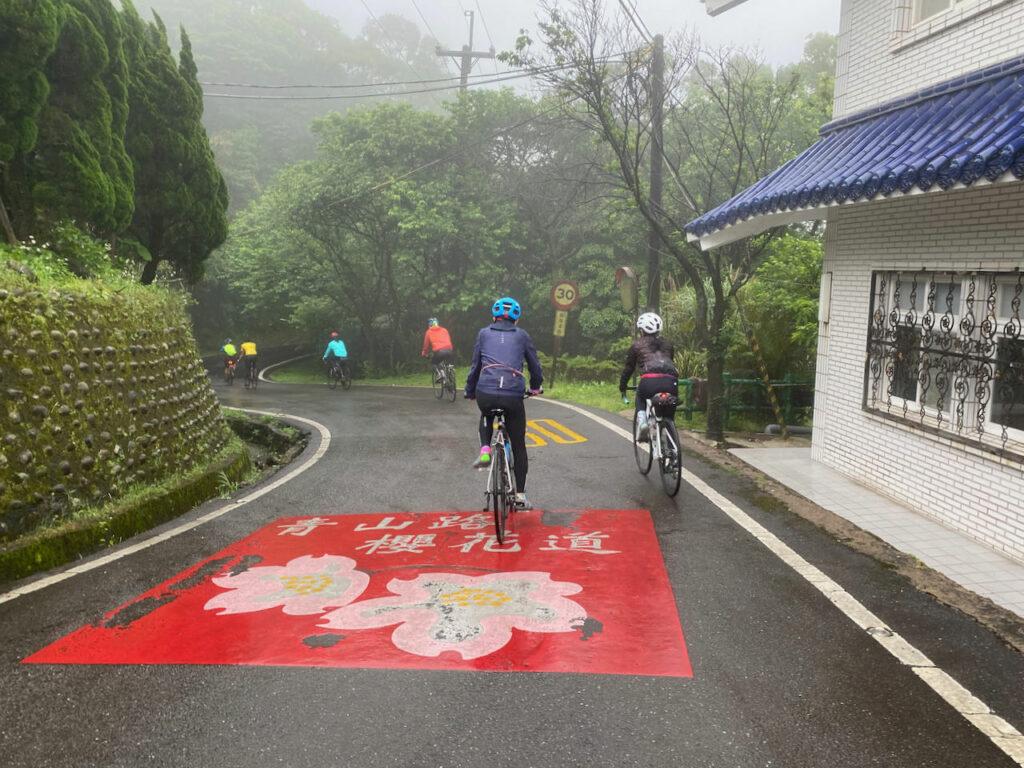
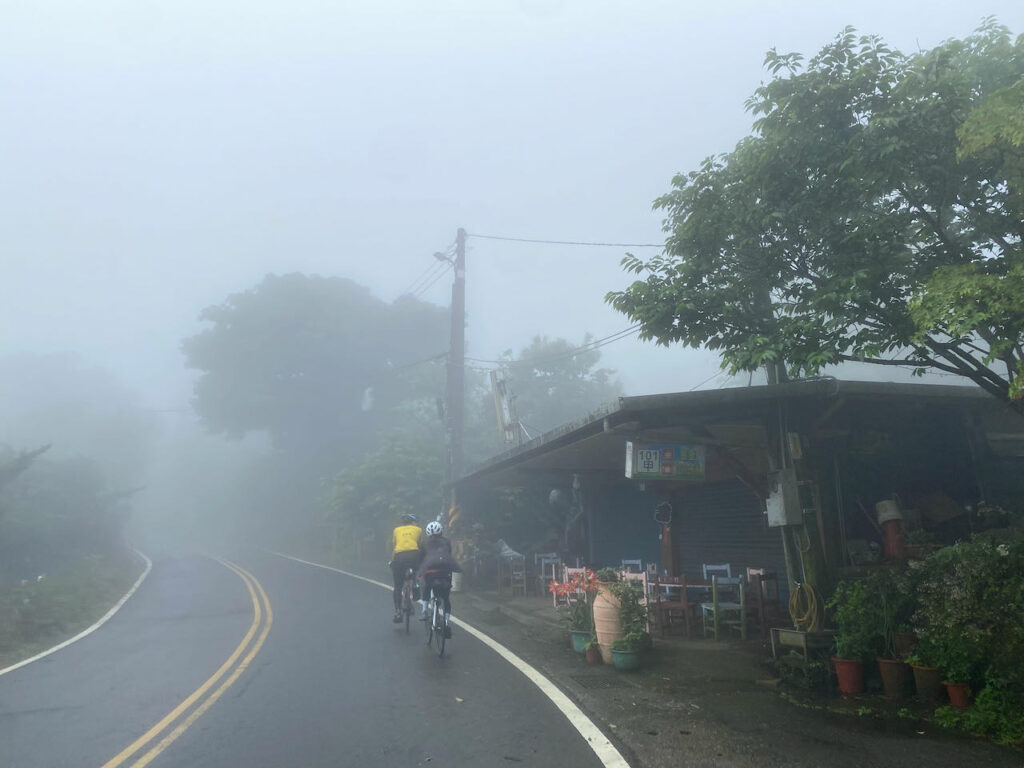
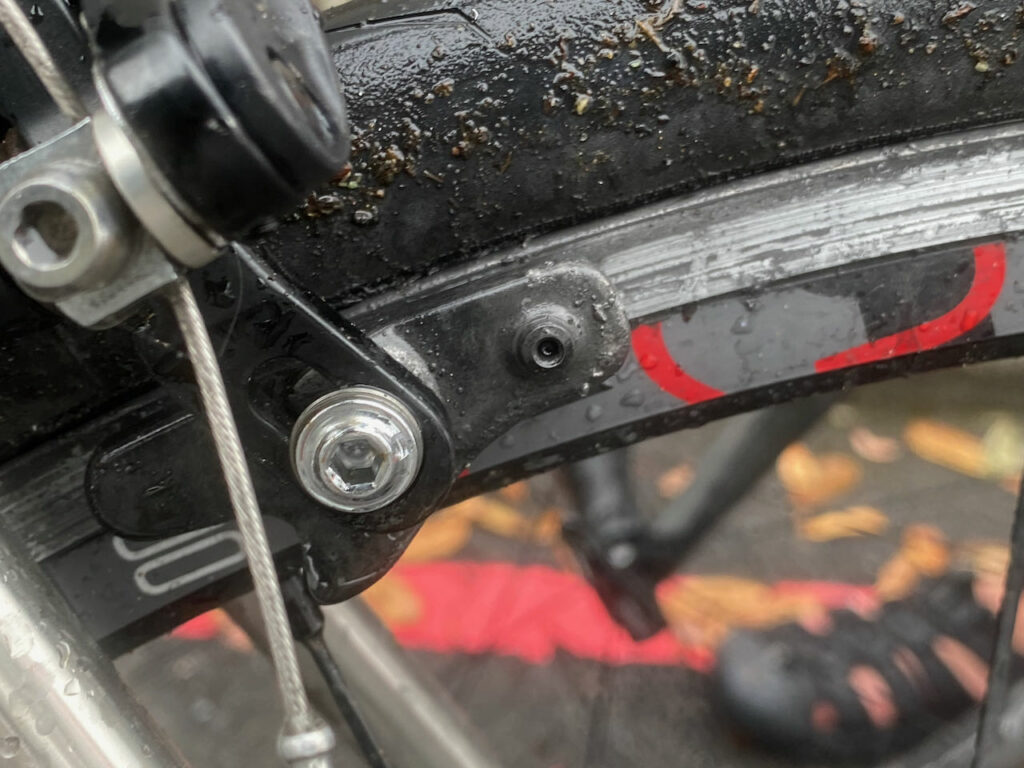
ルート
- Garmin: https://connect.garmin.com/modern/course/241344298
- komoot: https://www.komoot.com/tour/1144820831
註記:ルートを使用するには、スマートフォンにアプリをインストールしてください。スマートフォンのブラウザで上記のリンクをタップすると、アプリが自動的に起動してルートを読み込みます。Garmin Connectの場合、アプリを使用してルートをGarminデバイスに送信できます。台湾で購入したGarminデバイスでない場合、デバイスに台湾地図がインストールされていることも確認する必要があります。このトピックに関する当社のブログ投稿もご覧いただけます
第2日目:角板山から宜蘭県大同郷へ(距離 86km、獲得標高 1,930m)
これは主に私のお気に入りの北横公路を走るルートでした。省道7号線の巴陵を過ぎた49.7km地点には交通規制があり、通行可能な時間帯は 11:00 – 12:00 と 16:00 – 17:00 の2回のみです。サポートカーは、私たちが閉鎖前に到着できるように、規制地点の近くまで運んでくれました。Eddie はサポートカーをうまく活用し、静かな渓谷の橋まで私たちを連れて行き、そこでサイクリングを開始しました。シンガポールの熱心なサイクリストであり、人気のサイクリンググループ「Cycling SG to Malaysia」を創設した Richard が、Eddie に提案し、私たちは全員で輪になって横たわり、素晴らしい写真を撮影しました。
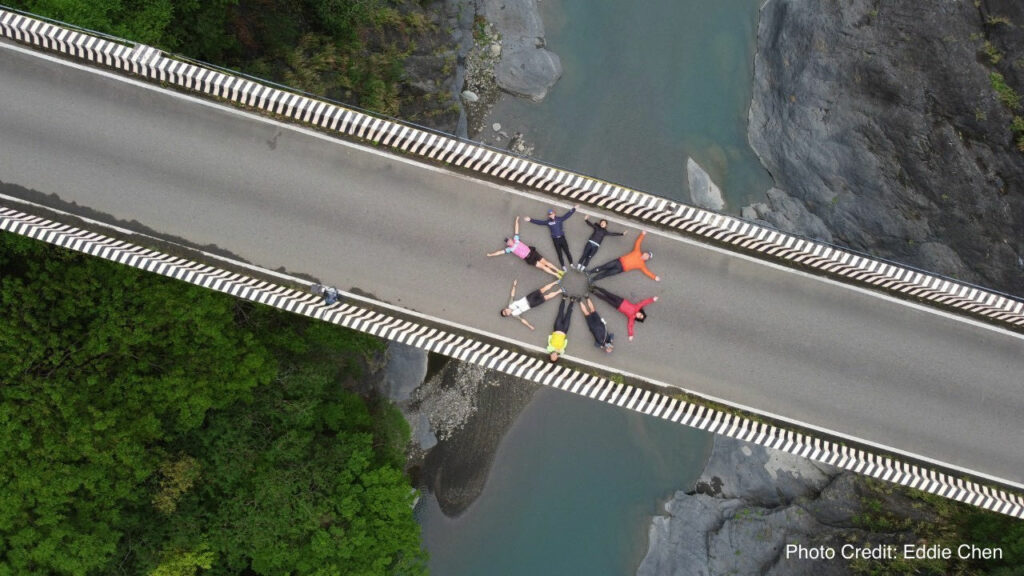
天気は最高でした。みんな、美しい曲がりくねった道を楽しみながらサイクリングしていました。しかし、注意すべき危険もいくつかありました。落石が発生しやすい区間を示す標識を見かけ、実際に道路上にいくつかの石が落ちていました。Eddie は、「落石の音が聞こえたら、すぐに逃げるべきだ。それはより大きな岩が落ちてくる前兆かもしれない」と言いました。
交通規制のある地点を通過するとき、山岳地帯ではどれほど無力になり得るかを痛感しました。大規模な地滑りで広範囲の緑が剥がれ落ち、不安定な泥の斜面がむき出しになっていました。道路工事作業員が数か月にわたって復旧作業を続けていたにもかかわらず、道路はまだ原型を留めていませんでした。私は自転車を降りて、ぬかるんだ道を押して進みました。
ペースを落とさずにカメラを構えて写真を撮ろうとした瞬間、作業員に大声で怒鳴られました。本来なら、何もせずにできるだけ素早く通過しなければならなかったのです。落石はいつでも起こり得る状況でした。怒られるのも当然でした。完全に私のミスでした。
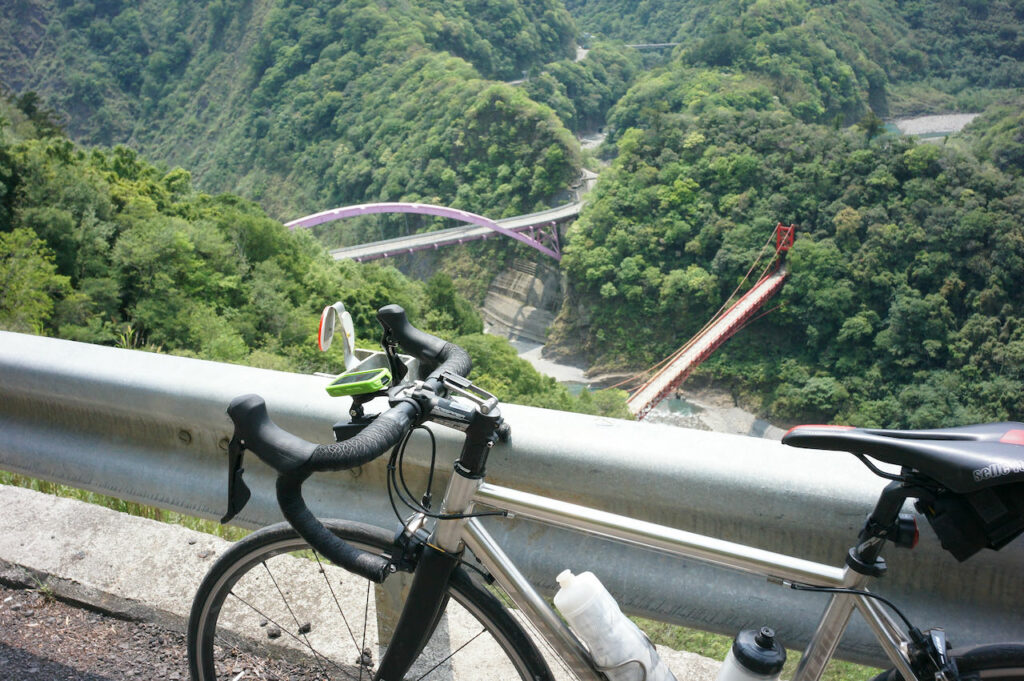

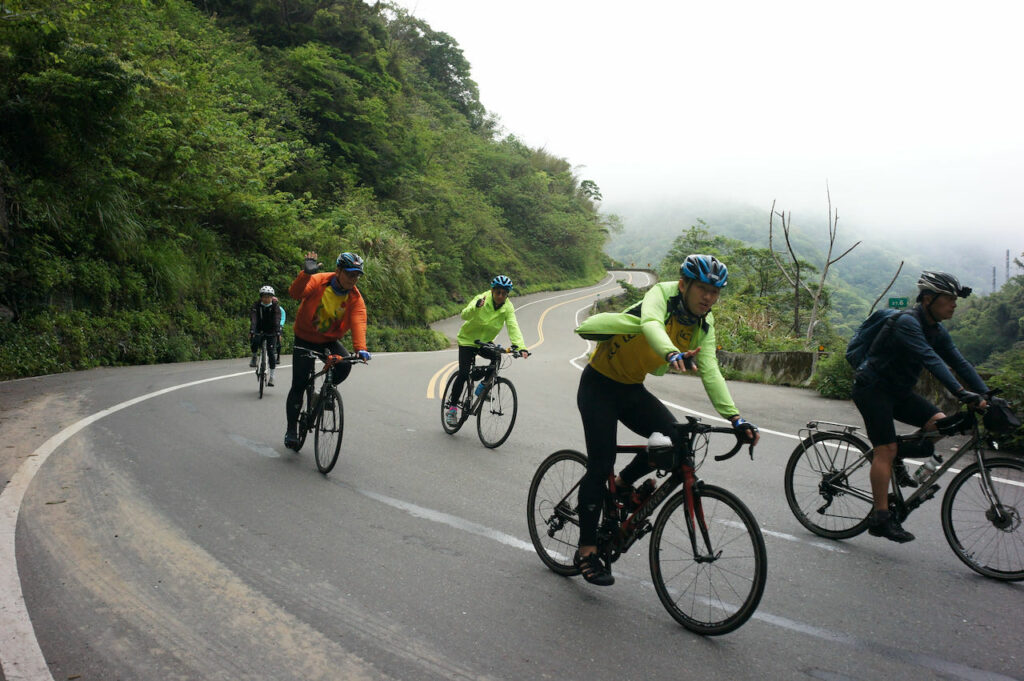
北横公路の巴陵を過ぎて交通規制エリアを抜けると、走行はとても快適になりました。勾配は緩やかで、ほとんど車も通らず、静かな道でした。沿道には奇妙で興味深い植物が生い茂り、どこか神秘的な雰囲気が漂っていました。14:30頃、明池国家森林遊楽区に到着し、この日最後のピークを迎えました。北横公路は私たちを深く静かな森の中へと導いていました。ここのリゾートは、宿泊や長期の滞在に適した素晴らしい場所です。
山の東側へ下り始めると、霧が次第に濃くなってきました。太平洋からの湿気が季節風によって山肌を這い上がり、この標高の冷えた空気で凝縮して霧を作り出していたのです。ある時点では、目の前の道路脇に描かれた白線を頼りに進むしかありませんでした。チームの姿はすでに遠く、見えなくなっていました。タイヤは道路の水と泥を巻き上げ、ブレーキパッドとの摩擦が激しくなり、異音を立てるようになりました。ブレーキを少し緩めて泥を落とし、再びブレーキをかけるという動作を繰り返しましたが、しばらくするとまた不気味な音が大きくなってきました。予備のブレーキパッドを持っていたことを心底ありがたく思いました。
途中、赤い旗がはためいているのが見え、近づくと道路補修作業をしているチームでした。彼らが何をしていたのかは分かりませんでしたが、こうした過酷な環境の中で働く姿に敬意を抱きました。今振り返ると、この体験全体がどこか現実離れしていて、とても美しく感じられます。
私たちは省道7号線の77K地点で集合し、サポートカーに乗って宿泊先の農場兼B&Bへ向かいました。チームと合流し、車に乗り込んだ瞬間、それまでの不思議な旅から目覚めたような気分になりました。この先、百韜橋に向かう道には、さらに急勾配で湿った下り坂が続くと言われています。自力で下りたい人は、その点を念頭に置いておくべきでしょう。
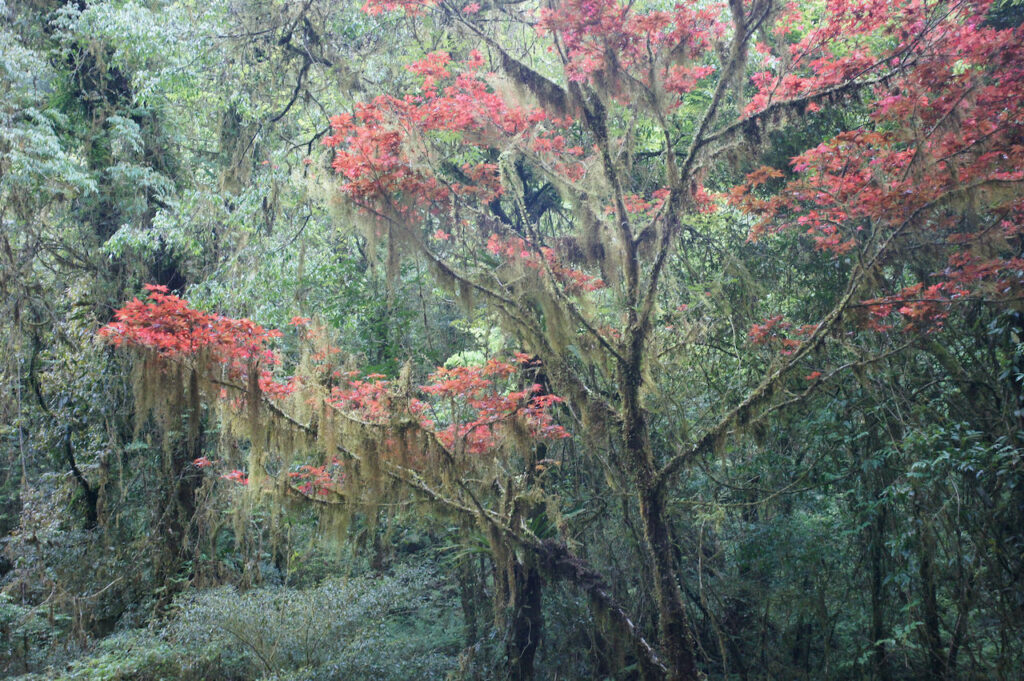
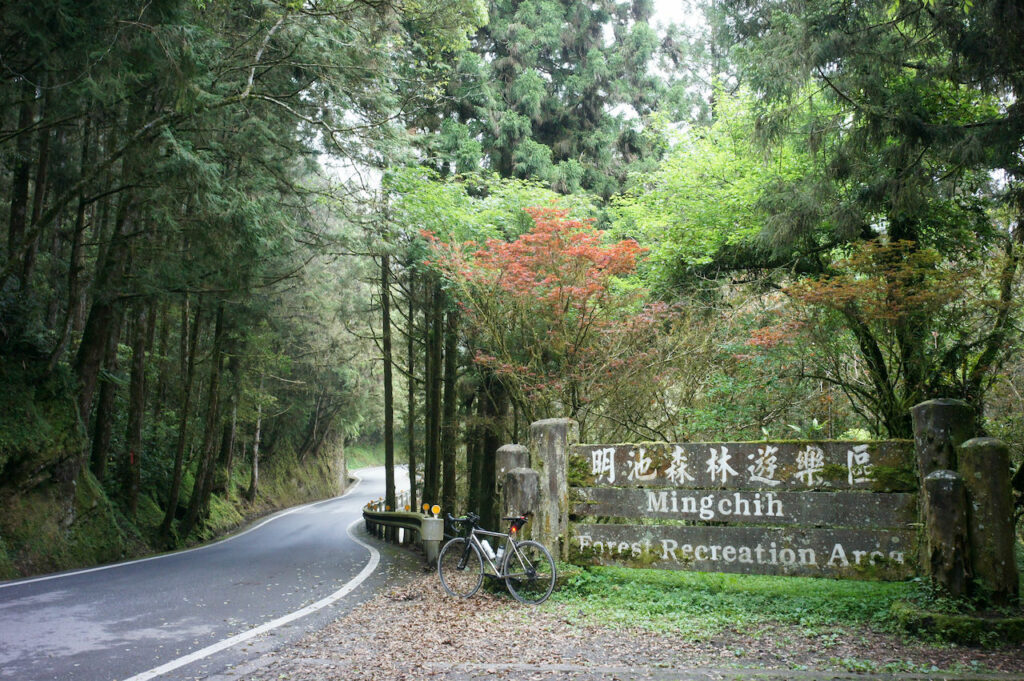
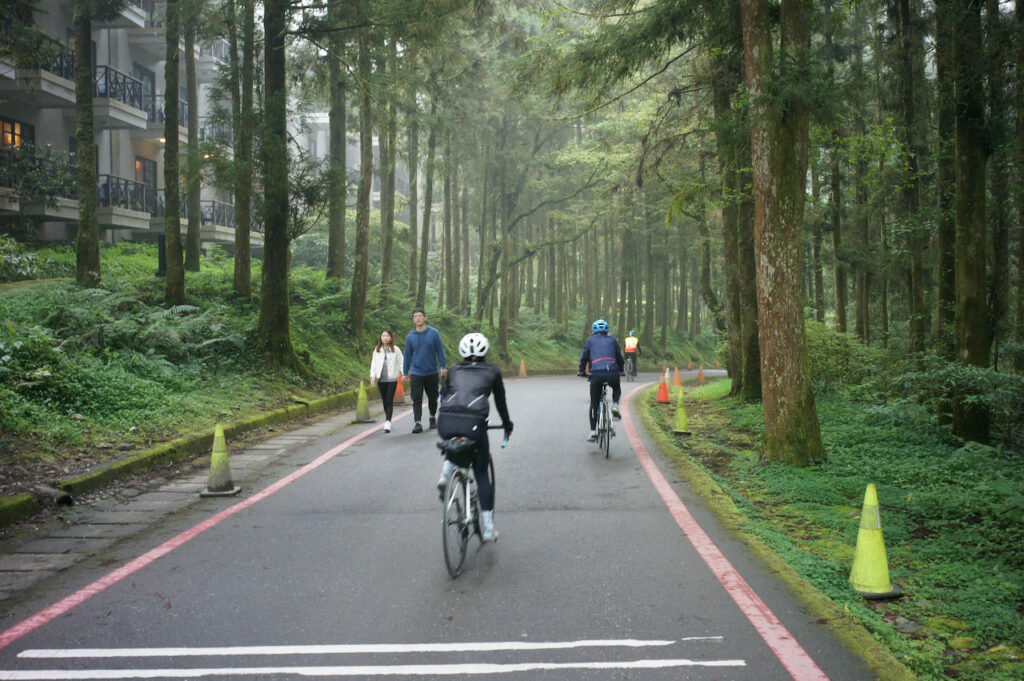
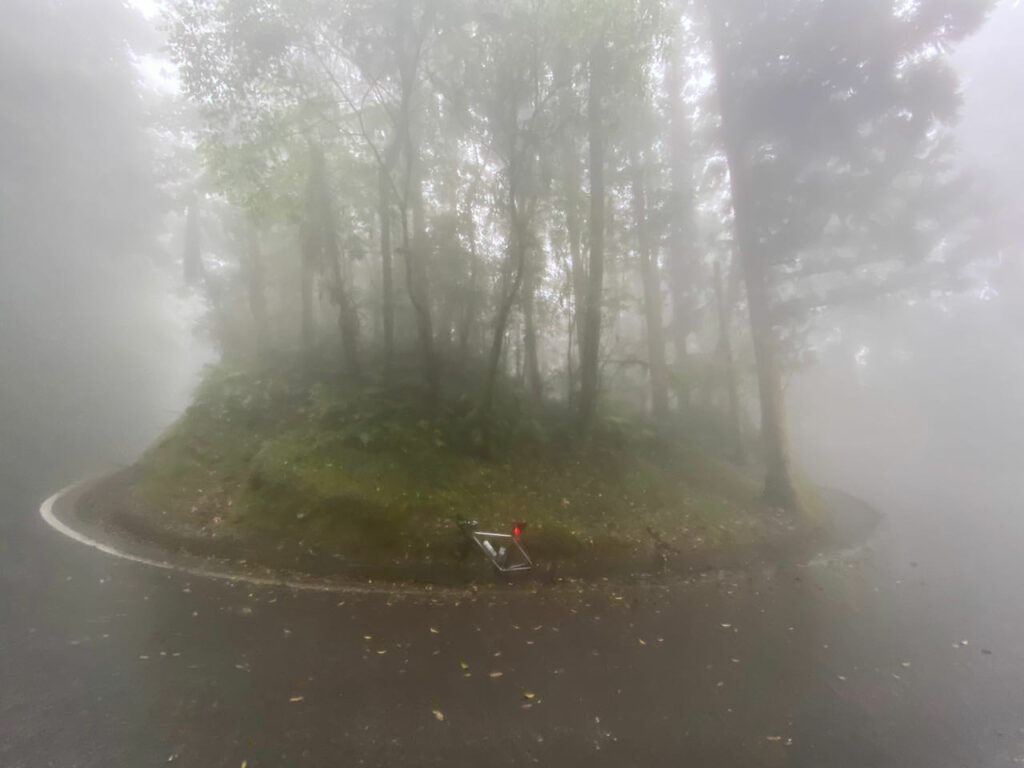
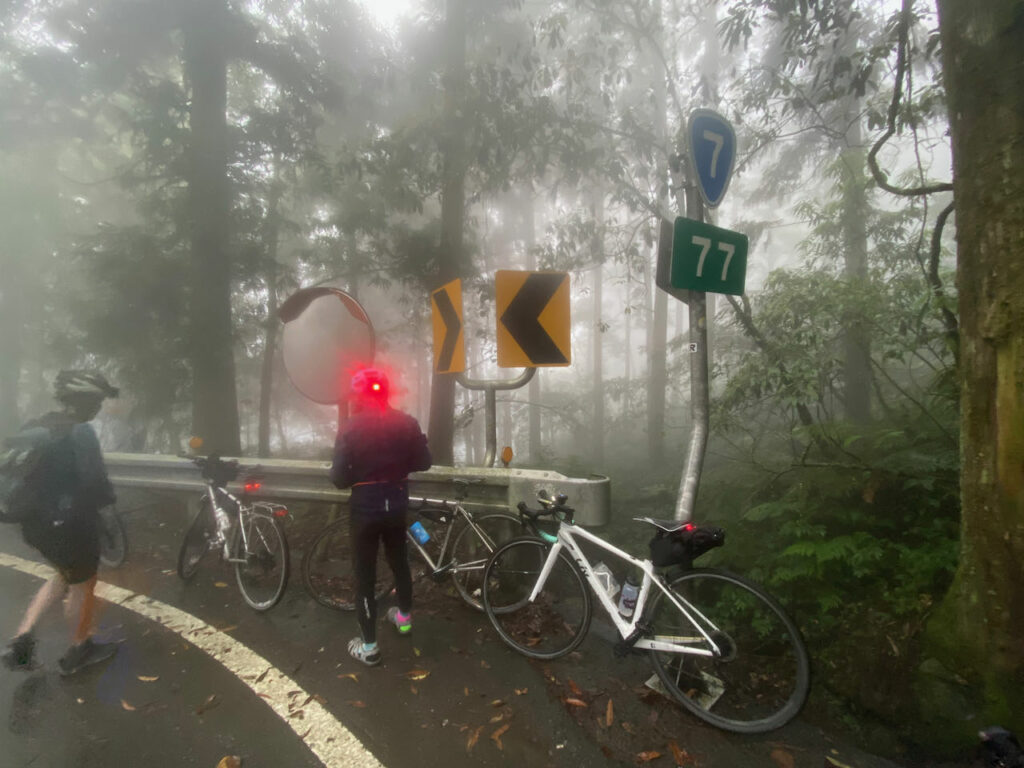
ルート
- Garmin: https://connect.garmin.com/modern/course/241344348
- komoot: https://www.komoot.com/tour/1144833774
註記:ルートを使用するには、スマートフォンにアプリをインストールしてください。スマートフォンのブラウザで上記のリンクをタップすると、アプリが自動的に起動してルートを読み込みます。Garmin Connectの場合、アプリを使用してルートをGarminデバイスに送信できます。台湾で購入したGarminデバイスでない場合、デバイスに台湾地図がインストールされていることも確認する必要があります。このトピックに関する当社のブログ投稿もご覧いただけます
第3日目:宜蘭・大同郷から梨山へ(距離 61km、獲得標高 2,085m)
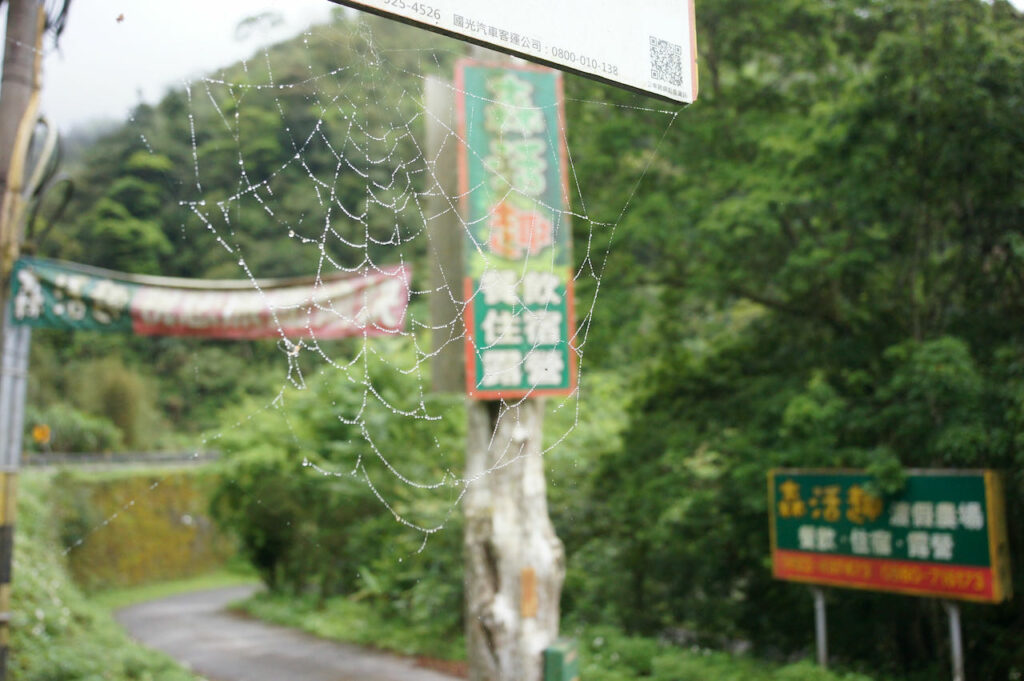
それは、省道7甲(7A)をひたすら登り続ける長い安定したクライムだった。標高が上がるにつれて、再び幻想的な霧の世界に包まれた。今日は、精神的にリラックスして楽しむことができた。下りと違って、登りではそれほど集中力を要しないからだ。
道の両側にはキャベツ畑が広がっていた。これらの白い野菜は、台湾のレストランや食卓でよく見かける日常的な食材だ。メインロード沿いに点在するタイヤル族の集落の中でも、南山部落は最も重要な補給地点だった。ここには、2軒のコンビニとガソリンスタンドがある。Eddieとドライバーは、さらに登って思源埡口(以前は匹亞南鞍部として知られていた)に到達する前に、ここで昼食を調達してくれた。この峠は、中央山脈から雪山山脈へと移る地点に位置する。
昼食のために思源埡口に停まると、一気に寒さを感じた。私は、フリースのセーター、軽量ダウンジャケット、ウインドブレーカーをすべて着込まなければならなかった。湿気と薄い空気が、メンバーの一人の体温を奪い、彼は軽いめまいを感じていた。
しかし、山は不思議な力を見せた。思源埡口からわずか数分下ると、一転して青空の下、日差しを浴びることができた。気温は一気に10度以上上昇し、私たちは活気を取り戻した。そのままの勢いで梨山へと走り続け、ついに自力で到達することができた。
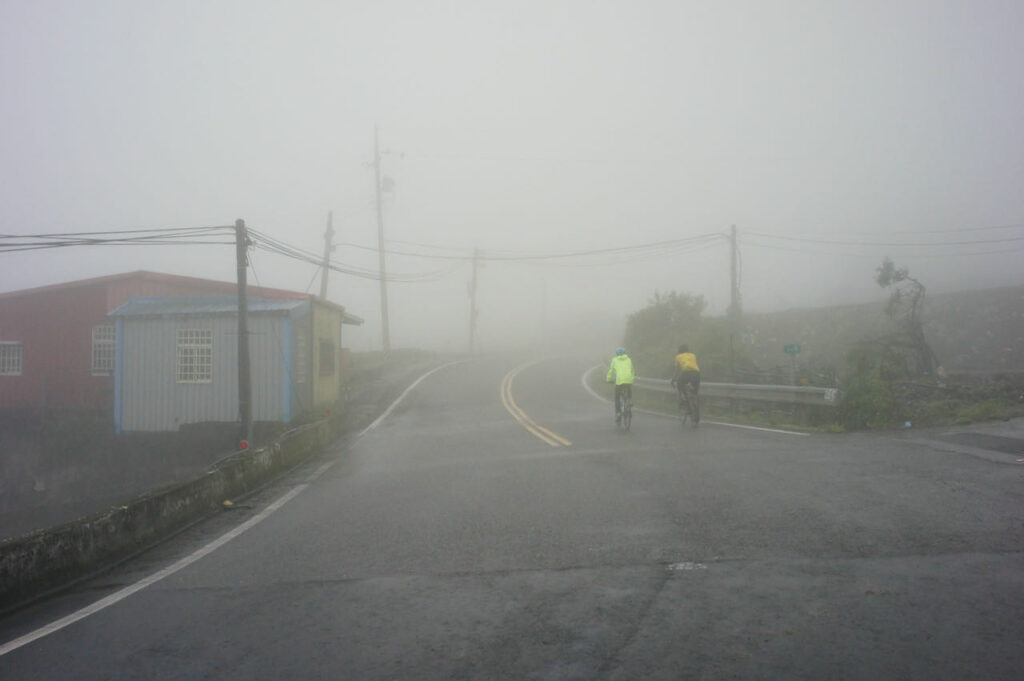
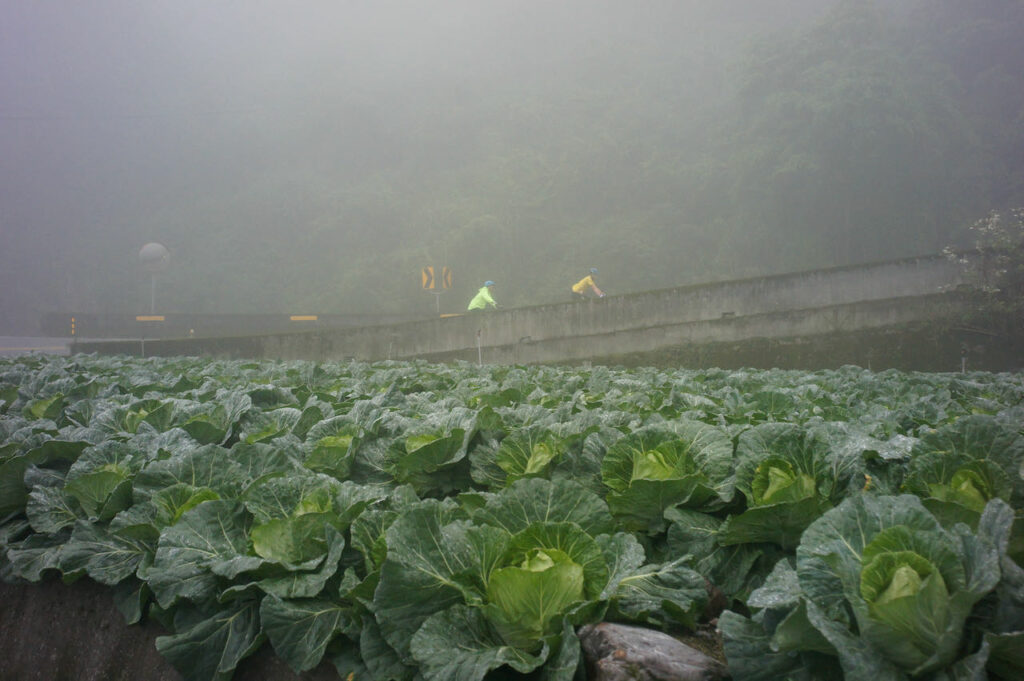
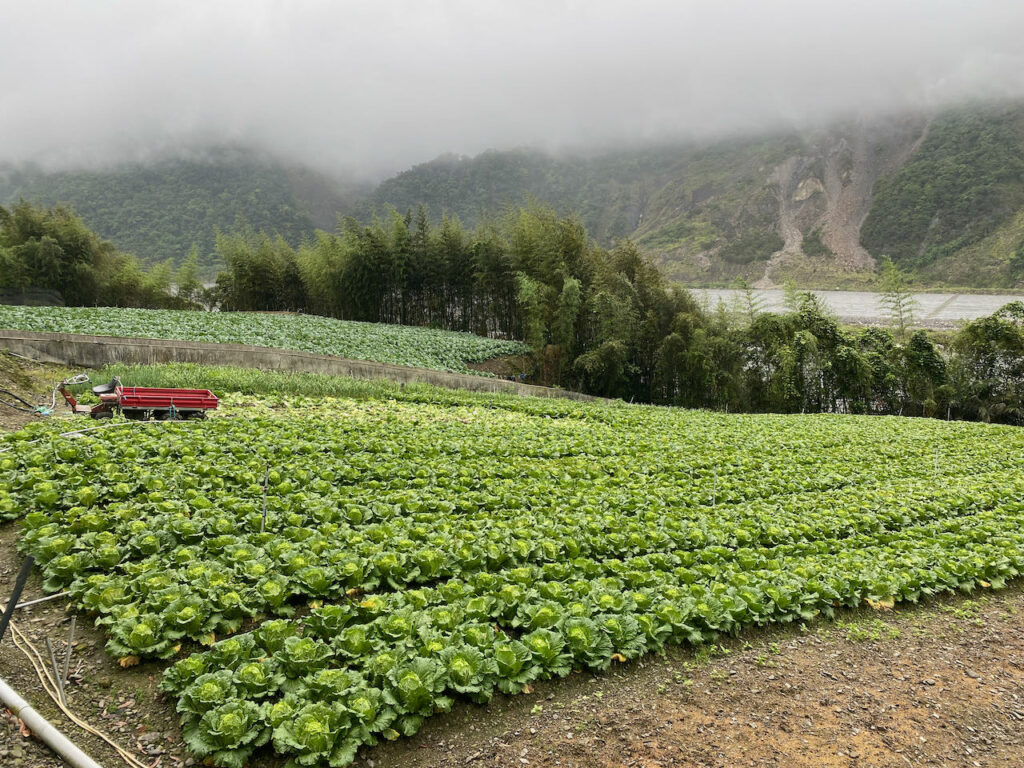
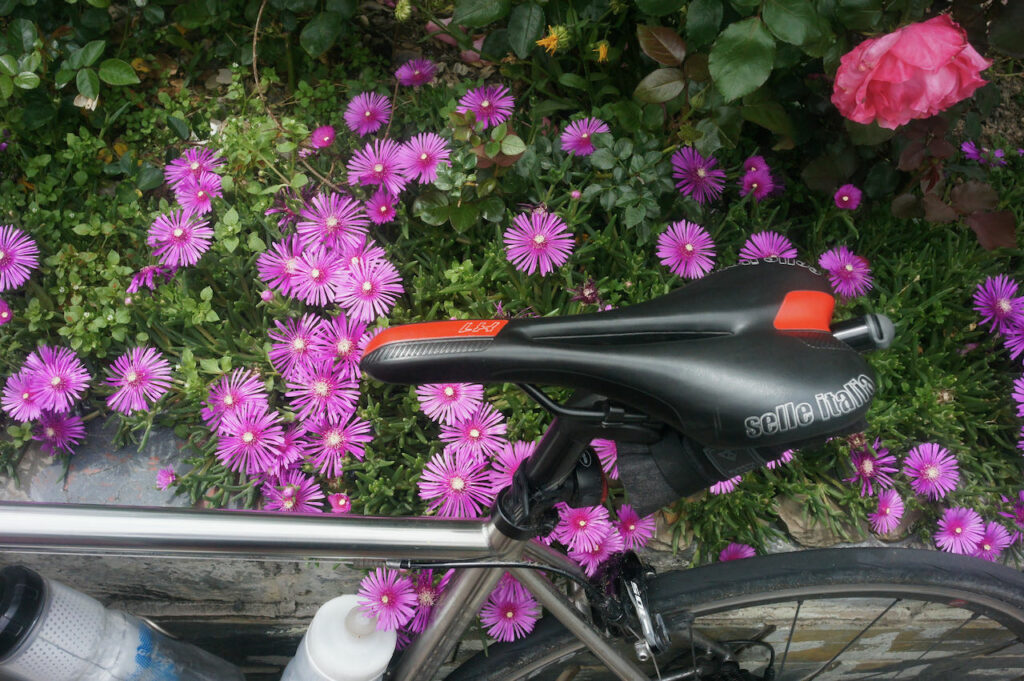
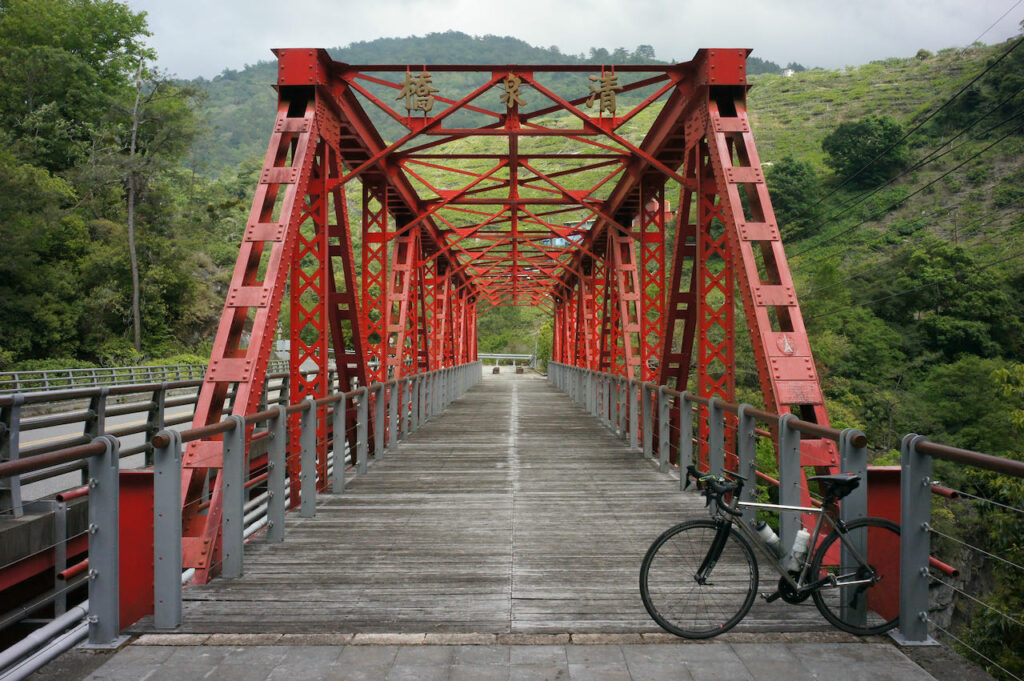
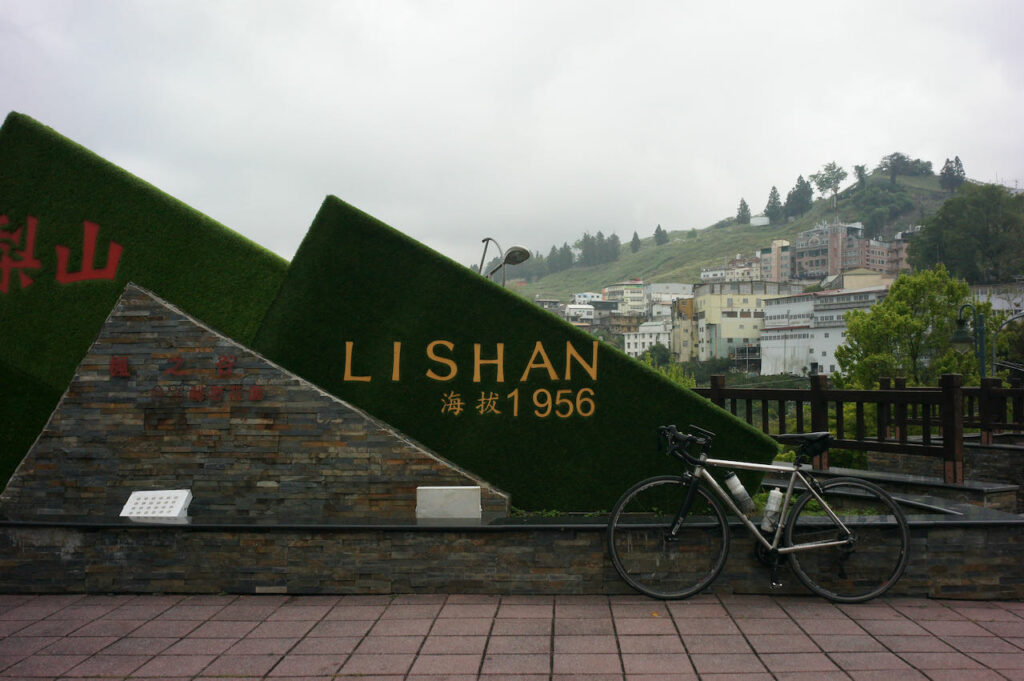
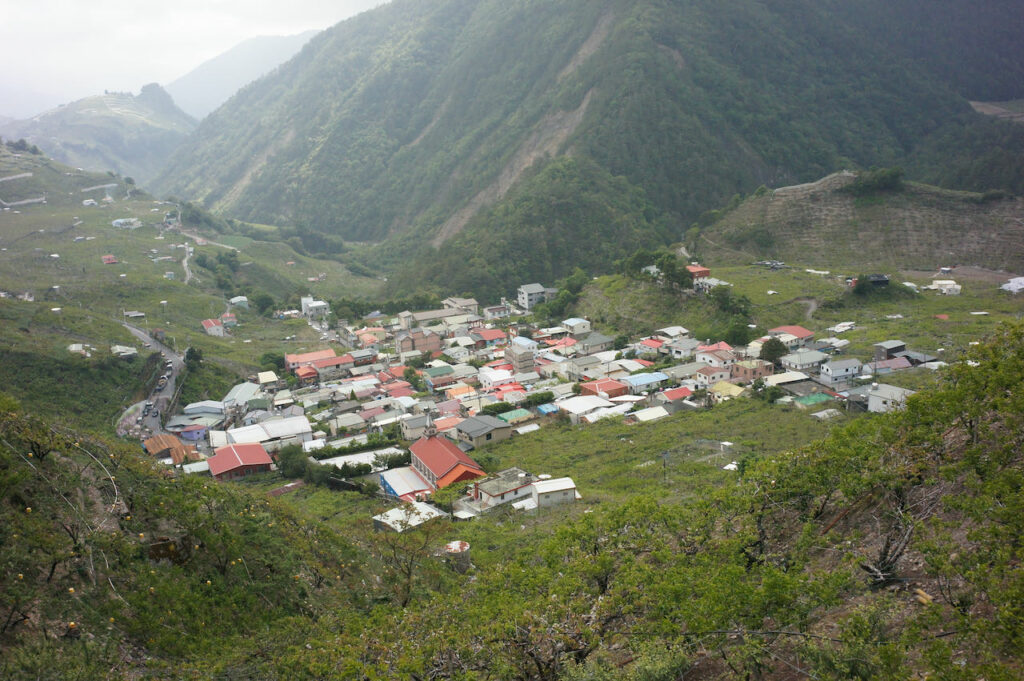
ルート
- Garmin: https://connect.garmin.com/modern/course/241344418
- komoot: https://www.komoot.com/tour/1144837452
註記:ルートを使用するには、スマートフォンにアプリをインストールしてください。スマートフォンのブラウザで上記のリンクをタップすると、アプリが自動的に起動してルートを読み込みます。Garmin Connectの場合、アプリを使用してルートをGarminデバイスに送信できます。台湾で購入したGarminデバイスでない場合、デバイスに台湾地図がインストールされていることも確認する必要があります。このトピックに関する当社のブログ投稿もご覧いただけます
第4日目:梨山から武嶺峠、そして春陽温泉へ(距離 78.8km、獲得標高 1,655m)
今日は、標高3,275メートルに位置する台湾最高峰の舗装道路、武嶺峠に到達した。獲得標高は「たったの」1,655メートルで、私にとっては典型的な長距離クライムの1日だ。しかし、薄い空気と急勾配のため、極めて過酷な挑戦となった。
梨山を出発し、そのまま登りを続けた。平均勾配は3.1%で、それほど厳しくはなかった。しかし、大禹嶺(標高2,565メートル)に到達すると、勾配が一気に8.3%に跳ね上がった。特に急カーブのヘアピン内では、数値以上の急勾配を体感し、体力を大きく奪われた。大禹嶺から合歓山サービスステーションまでの5km区間は、花蓮側から登る場合でも宜蘭側から登る場合でも、最も急な登坂だと言われている。
カーブの手前で写真を撮るために停車したとき、頂上から下ってくるオートバイや車が、ブレーキを強くかけなければならないのを目にした。焦げたブレーキパッドの匂いが空気中に充満していた。もしスピードを落とせずに曲がりきれなかった場合に備えて、壁には古いタイヤがクッション材として設置されていた。
もし無理をしすぎれば、高山病を引き起こすかもしれないという不安があった。数年前にネパールでトレッキングをした際に経験したことがあり、その症状をよく知っている。5年前、サイクリングを始めたばかりの頃、武嶺峠への登頂に失敗したことがあった。今回は2回目の挑戦であり、何としても成功させたかった。
前夜に大きな缶ビールを飲んだことを後悔した。それが体調に影響しているかもしれないと思ったからだ。ゆっくりと進み、ときには自転車を押しながら登った。ペースが遅くても気にしなかった。むしろ、頻繁に立ち止まり、写真を撮った。なぜなら、カーブを曲がるたびに現れる壮大な景色を無視することはできなかったからだ。
最後の登りに入る前に、山はわずかな休息を与えてくれた。1.2kmの区間で76メートルの下りがあり、その後、11%以上の勾配で最後の162メートルを登ることになった。
幸運なことに、天候は素晴らしかった。私は忍耐強く坂を登り続け、ついに頂上に到達した。そこからの景色は壮観だった。しばらくその場にとどまり、達成感に浸りながら周囲の山々を眺めた。一方で、チームの仲間たちはすでに車に乗り込み、ホテルへ向かう準備ができていた。私は確信している。きっとまたこの峠に挑戦するだろう。
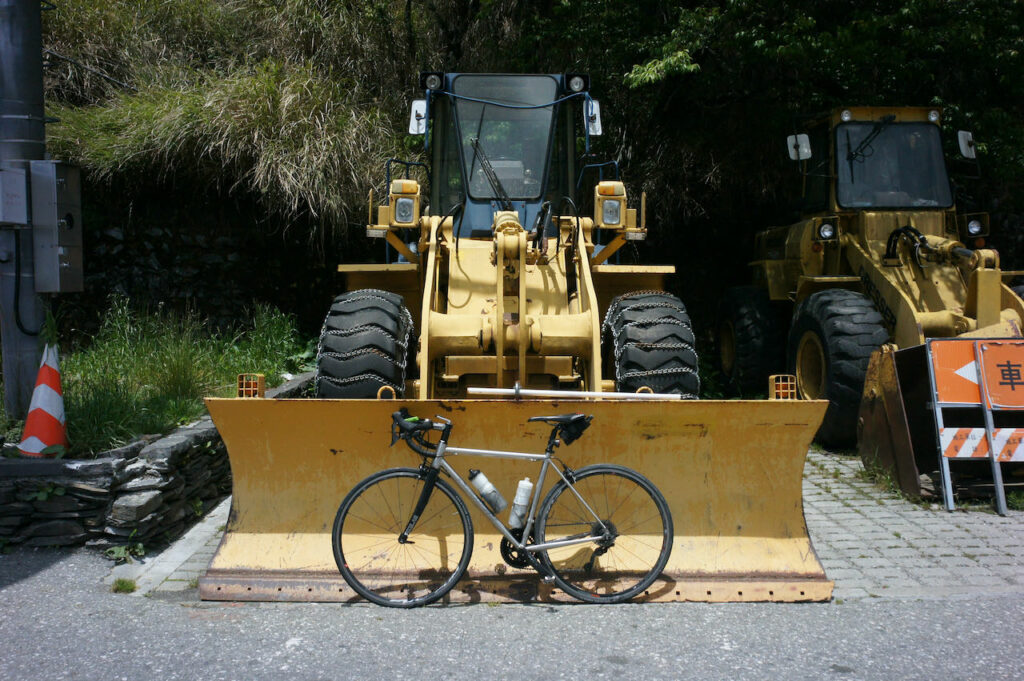
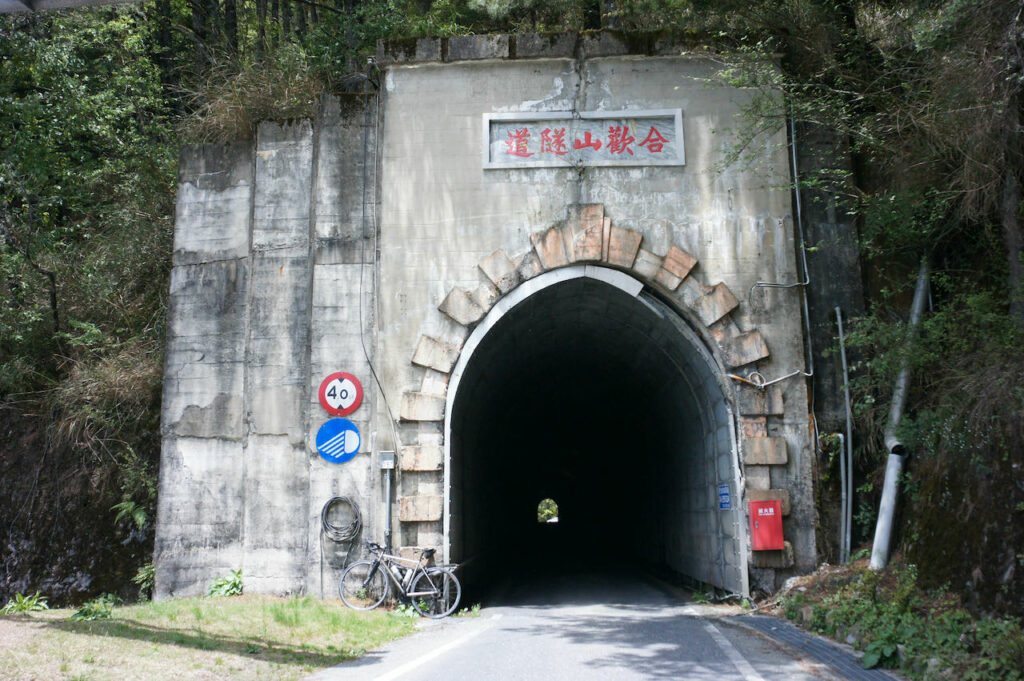
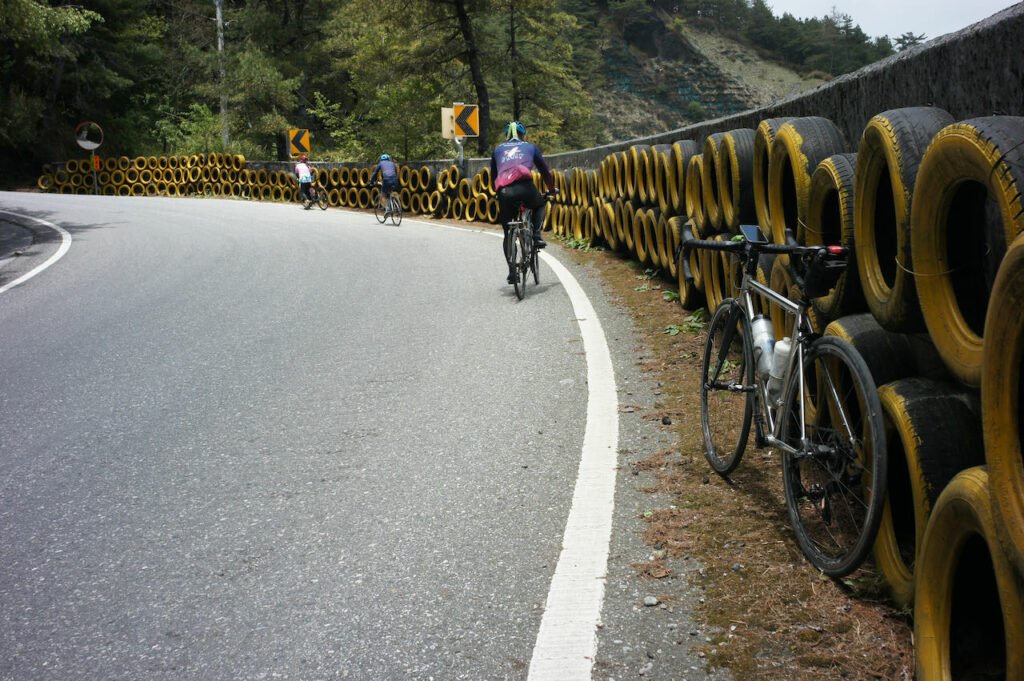
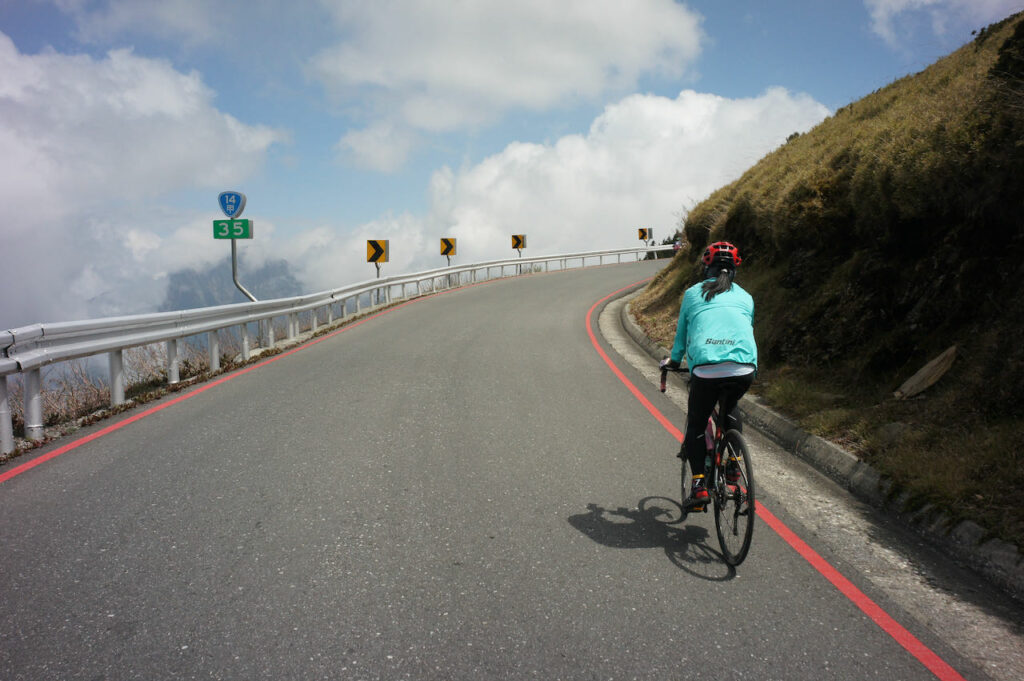
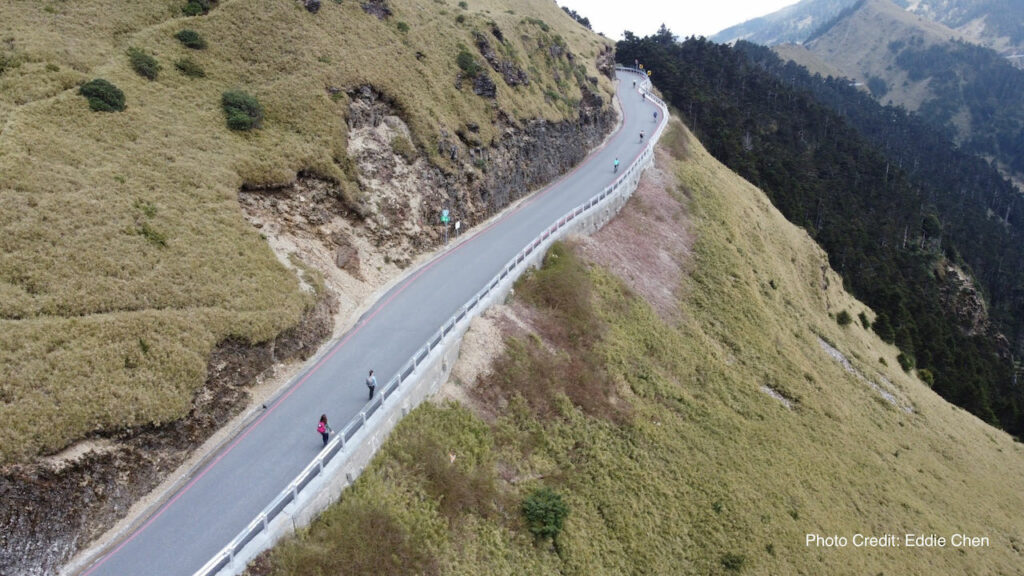
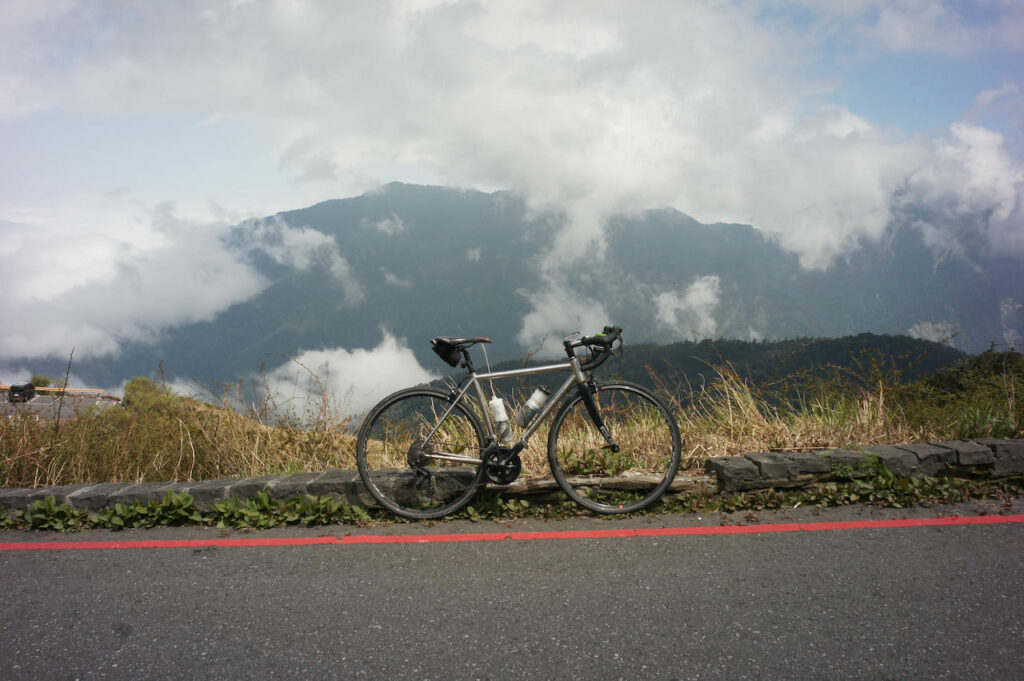
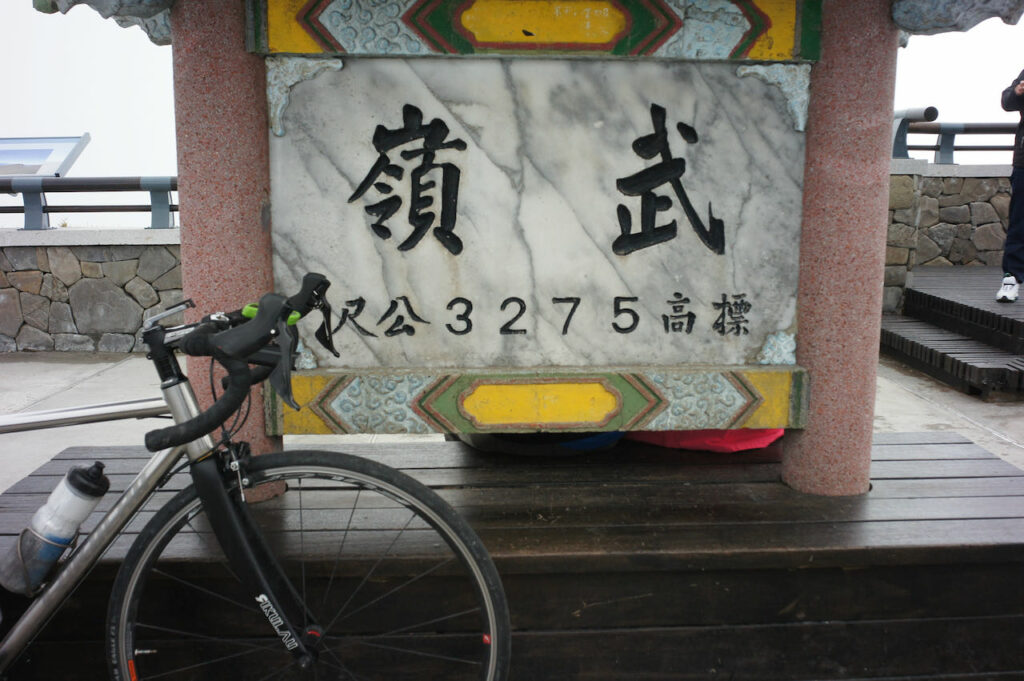
ルート
- Garmin: https://connect.garmin.com/modern/course/241344443
- komoot: https://www.komoot.com/tour/1144898455
註記:ルートを使用するには、スマートフォンにアプリをインストールしてください。スマートフォンのブラウザで上記のリンクをタップすると、アプリが自動的に起動してルートを読み込みます。Garmin Connectの場合、アプリを使用してルートをGarminデバイスに送信できます。台湾で購入したGarminデバイスでない場合、デバイスに台湾地図がインストールされていることも確認する必要があります。このトピックに関する当社のブログ投稿もご覧いただけます
第5日目:春陽温泉から埔里へ(距離 55km、獲得標高 855m)
この旅の最終日だった。武嶺を登った後、大半の人は省道14甲(14A)を使って直接埔里へ下る。しかし、Eddie は私たちを武界へ案内してくれた。そこは、先住民族の布農族の人々が暮らす地域だ。このルートは登りが多かったが、交通量が少なく、より快適に走ることができた。昼食は、布農族出身のシェフが用意してくれた美味しい料理だった。武界から埔里への最後の下りは油断できなかった。長く急な下り坂が続き、道路には金属製の排水グレーチングが敷かれている箇所がいくつもあった。路面が濡れていると滑りやすくなるため、細心の注意を払う必要があった。
これで、私の5日間の旅は終わった。最後の3日間は天気に恵まれたおかげで、ブレーキパッドは何とか持ちこたえた。実際には、まだ少し余裕があった。
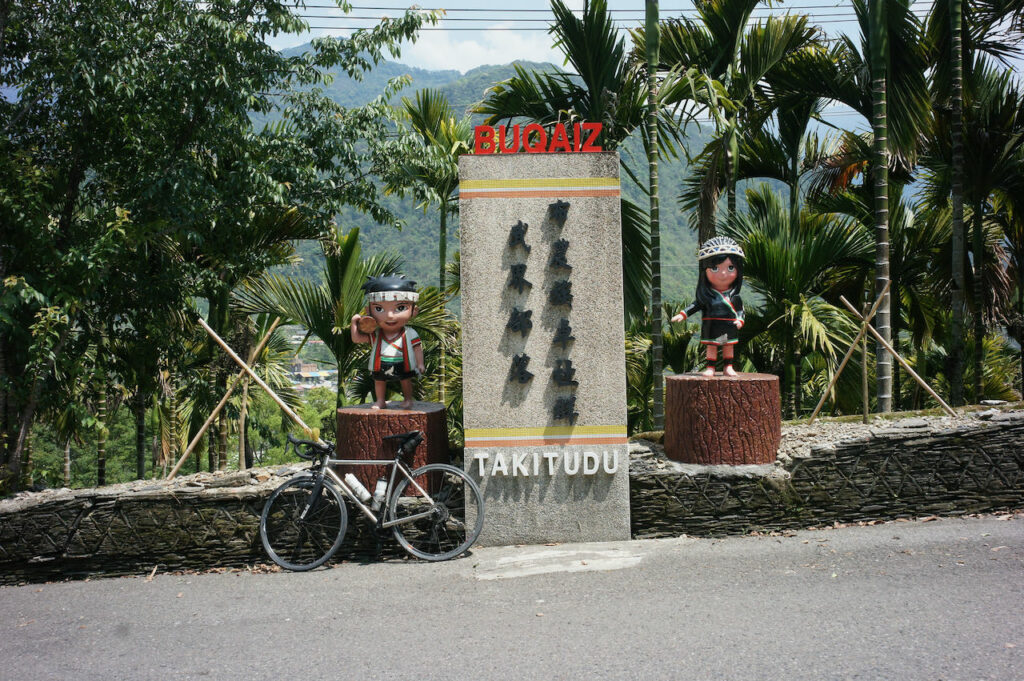
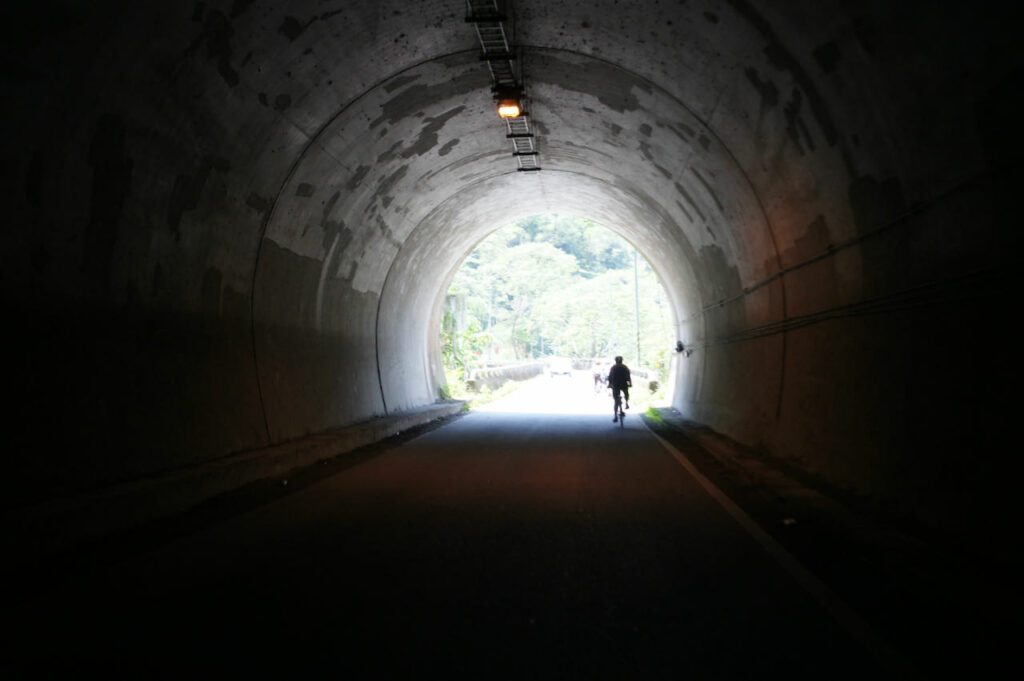
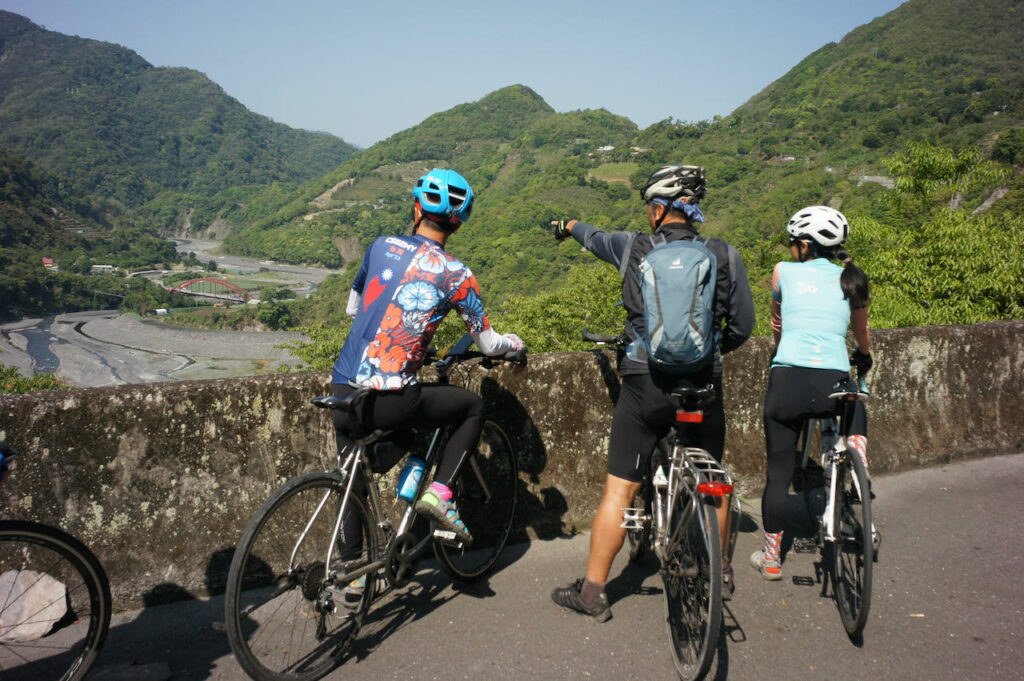
ルート
- Garmin: https://connect.garmin.com/modern/course/241344464
- komoot: https://www.komoot.com/tour/1144902142
註記:ルートを使用するには、スマートフォンにアプリをインストールしてください。スマートフォンのブラウザで上記のリンクをタップすると、アプリが自動的に起動してルートを読み込みます。Garmin Connectの場合、アプリを使用してルートをGarminデバイスに送信できます。台湾で購入したGarminデバイスでない場合、デバイスに台湾地図がインストールされていることも確認する必要があります。このトピックに関する当社のブログ投稿もご覧いただけます
旅の締めくくり
Eddie とチームメンバーと共にサイクリングした時間は素晴らしいものだった。彼らは皆、並外れた忍耐力を持つサイクリストだ。山岳地帯にはさまざまな制約があるものの、Eddie は、1日のライドの後に清潔で快適な宿泊先を手配してくれた。食事も多彩で十分に満たされた。サポートカーは絶妙なタイミングで現れ、補給や個人の荷物へのアクセスを可能にしてくれた。私は計画されたルートのすべてを自転車で走りきることはできなかったが、Eddie のツアーのおかげで、高地を含む山岳地帯でのサイクリングの雰囲気を味わうことができた。
Eddie は何年にもわたって山岳地帯を走り続けており、そこに住む先住民族とも親交がある。毎年クリスマスには、バリン(Baling)でのライドを企画し、タイヤル族(Atayal)の人々と交流している。しかし、今回の旅では、先住民族との触れ合いの機会はほとんどなかった。Eddie によると、その理由はサポートカーの存在にあるという。サポートカーが同行していると、周囲の人々は「私たちは十分に世話を受けている」と認識し、特に関わる必要がないと判断するのだ。しかし、Eddie が単独で自転車旅行をしていると、人々との間の垣根はなくなり、温かいもてなしを受けることが多いという。彼は、見ず知らずの人々から家庭料理をごちそうになったり、親切に接してもらったりすることがよくあるそうだ。
私は自由な旅を好むタイプであり、本来なら自分で計画したルートを自転車で巡るのが理想だ。自分の荷物を背負い、山岳地帯を気ままに走るのが最も楽しい。しかし、幼い子どもが2人おり、会社を経営している今の生活では、それは難しい。
経験豊富なサイクリストであれば、このような旅を自力で 行うことも可能だ。ただし、ルートを入念に計画し、補給ポイントや宿泊施設を事前に把握しておくことが不可欠である。天候や道路の封鎖情報にも十分注意する必要がある。また、一部のエリアでは携帯電話の電波が届かないこともあるため、その点も考慮すべきだ。
私たちのお客様の中にも、事前にしっかりとリサーチを行い、自分で山岳ルートを設定して走る人がいる。彼らが私に求めるのは、最新の道路状況に関する簡単なコメントと、自転車や必要なアクセサリーの手配だけだ。
もし自分で旅を計画したいなら、以下の情報源が役立つだろう。
- 中央気象局(Central Weather Bureau): https://www.cwa.gov.tw/V8/C/
- 省道の交通規制情報: https://168.thb.gov.tw/thb168 (More details on how to use the website on this post: Cycling the Five Extremes Around Taiwan)
